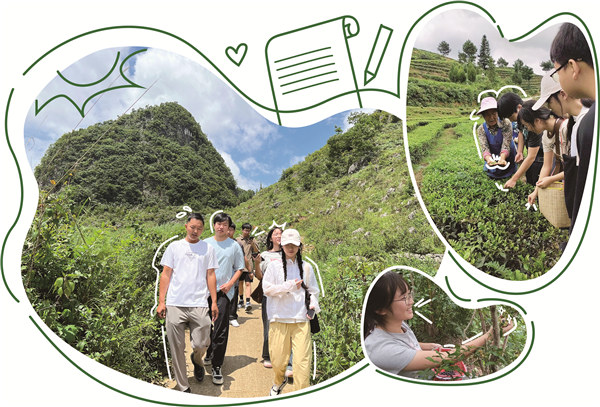

Students participate in the "Sanxiaxiang Program" in Guizhou to explore how rural revitalization efforts have transformed the area.
During high school, when Zhang Yuehui first arrived in Ziyun, a Miao-Bouyei autonomous county in Southwest China's Guizhou province, he encountered a region struggling with poverty. The roads from the county seat to neighboring villages were muddy and rough due to a lack of infrastructure.
Now, as a 20-year-old student at the Southwestern University of Finance and Economics in Chengdu, Sichuan province, Zhang was pleasantly surprised by the remarkable changes that had taken place in the area.
In 2020, Ziyun, one of the last counties to eliminate poverty, reached a significant milestone in China's battle against poverty.
But how can these achievements be sustained and expanded? In July, Zhang and his classmates found an answer by visiting the county.
Their exploration was part of the "Sanxiaxiang Program", a series of social engagement initiatives encouraging college students to bring cultural, scientific, technological, and hygiene knowledge to rural communities.
"It allows us to step out of our schools and into rural areas to see firsthand how China's rural revitalization efforts are making a difference," Zhang said.
He leads a team of 10 students, with four focusing on online tasks such as video editing and data analysis. The remaining six, including him, traveled to Ziyun. Through field visits and interviews, they explored the region's economic development model and grassroots self-governance system.
In an interview with Ziyun's agriculture and rural affairs bureau, 20-year-old Jin Yuxin learned that agricultural production contributes to more than 60 percent of the county's GDP.
She discovered that Ziyun had leveraged its unique geographical advantages to develop an innovative agricultural approach: in the fertile northern areas, farmers are encouraged to grow sweet potatoes, tea, and blueberries, while in the southern regions, they are guided toward livestock farming.
Local farmers in Ziyun also process crops into products such as sweet potato noodles and blueberry jam or juice. "This not only boosts the value of agricultural products but also creates more job opportunities for local residents," Jin said.
Lyu Junfeng, a 20-year-old data analyst for the online team, was tasked with creating a word cloud to track the progress of local industries. Although he didn't participate in field visits, he used Python, a computer programming language, to analyze data collected by his team, along with information from Ziyun's official website and news reports.
His analysis revealed that "intensification" emerged as one of the key terms frequently associated with the local industry's development.
"This is closely tied to a business model based on sharing profits and risks that has been set up locally," he explained.
Jin, who observed the model in action, explained that the county has established a direct link between farmers and businesses through agricultural cooperatives, cutting out middlemen and ensuring farmers receive a larger share of the profits. The model also brings together small-scale farmers into modern, productive industries with the support of major corporations.